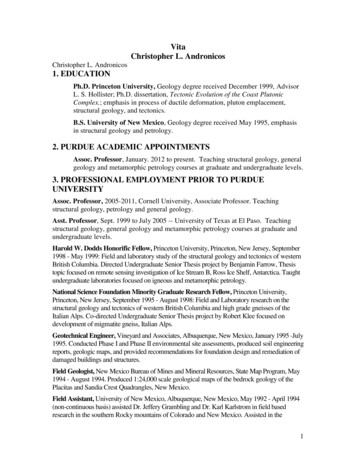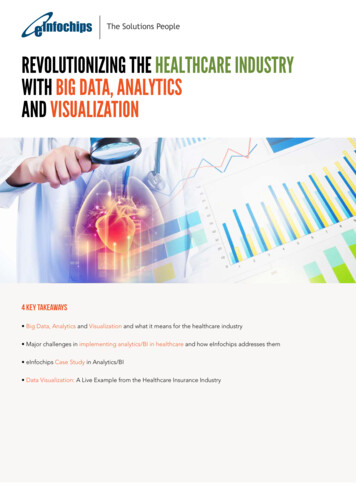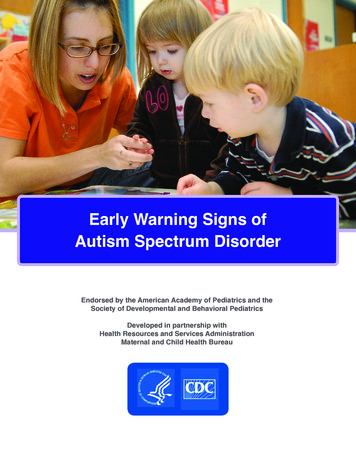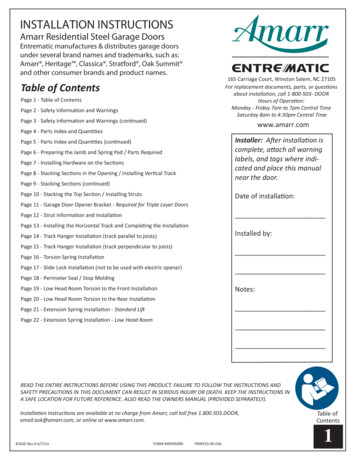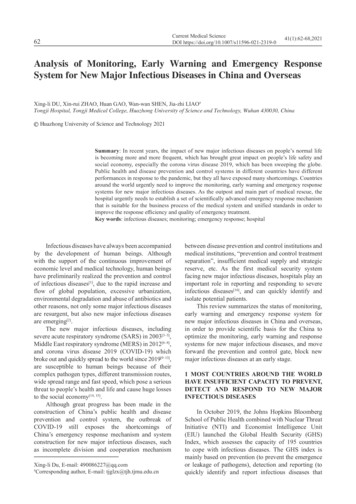
Transcription
Current Medical Science41(1):62-68,2021Current Medical Science 41(1):2021DOI s of Monitoring, Early Warning and Emergency ResponseSystem for New Major Infectious Diseases in China and OverseasXing-li DU, Xin-rui ZHAO, Huan GAO, Wan-wan SHEN, Jia-zhi LIAO#Tongji Hospital, Tongji Medical College, Huazhong University of Science and Technology, Wuhan 430030, ChinaHuazhong University of Science and Technology 2021Summary: In recent years, the impact of new major infectious diseases on people’s normal lifeis becoming more and more frequent, which has brought great impact on people’s life safety andsocial economy, especially the corona virus disease 2019, which has been sweeping the globe.Public health and disease prevention and control systems in different countries have differentperformances in response to the pandemic, but they all have exposed many shortcomings. Countriesaround the world urgently need to improve the monitoring, early warning and emergency responsesystems for new major infectious diseases. As the outpost and main part of medical rescue, thehospital urgently needs to establish a set of scientifically advanced emergency response mechanismthat is suitable for the business process of the medical system and unified standards in order toimprove the response efficiency and quality of emergency treatment.Key words: infectious diseases; monitoring; emergency response; hospitalInfectious diseases have always been accompaniedby the development of human beings. Althoughwith the support of the continuous improvement ofeconomic level and medical technology, human beingshave preliminarily realized the prevention and controlof infectious diseases[1], due to the rapid increase andflow of global population, excessive urbanization,environmental degradation and abuse of antibiotics andother reasons, not only some major infectious diseasesare resurgent, but also new major infectious diseasesare emerging[2].The new major infectious diseases, includingsevere acute respiratory syndrome (SARS) in 2003[3–5],Middle East respiratory syndrome (MERS) in 2012[6–8],and corona virus disease 2019 (COVID-19) whichbroke out and quickly spread to the world since 2019[9–13],are susceptible to human beings because of theircomplex pathogen types, different transmission routes,wide spread range and fast speed, which pose a seriousthreat to people’s health and life and cause huge lossesto the social economy[14, 15].Although great progress has been made in theconstruction of China’s public health and diseaseprevention and control system, the outbreak ofCOVID-19 still exposes the shortcomings ofChina’s emergency response mechanism and systemconstruction for new major infectious diseases, suchas incomplete division and cooperation mechanismXing-li Du, E-mail: 490086227@qq.com#Corresponding author, E-mail: tjglzx@tjh.tjmu.edu.cnbetween disease prevention and control institutions andmedical institutions, “prevention and control treatmentseparation”, insufficient medical supply and strategicreserve, etc. As the first medical security systemfacing new major infectious diseases, hospitals play animportant role in reporting and responding to severeinfectious diseases[16], and can quickly identify andisolate potential patients.This review summarizes the status of monitoring,early warning and emergency response system fornew major infectious diseases in China and overseas,in order to provide scientific basis for the China tooptimize the monitoring, early warning and responsesystems for new major infectious diseases, and moveforward the prevention and control gate, block newmajor infectious diseases at an early stage.1 MOST COUNTRIES AROUND THE WORLDHAVE INSUFFICIENT CAPACITY TO PREVENT,DETECT AND RESPOND TO NEW MAJORINFECTIOUS DISEASESIn October 2019, the Johns Hopkins BloombergSchool of Public Health combined with Nuclear ThreatInitiative (NTI) and Economist Intelligence Unit(EIU) launched the Global Health Security (GHS)Index, which assesses the capacity of 195 countriesto cope with infectious diseases. The GHS index ismainly based on prevention (to prevent the emergenceor leakage of pathogens), detection and reporting (toquickly identify and report infectious diseases that
63Current Medical Science 41(1):2021may cause global concern), rapid response (to quicklyrespond to and slow down the spread of infectiousdiseases), health system (to establish a robust healthsystem, to treat patients and protect medical staff),compliance with international norms (commitment toimprove the ability of countries, provide funds to repairshort board of health and safety, and abide by the globalrelevant specification) and risk environment (overallrisk environment and the vulnerability of countriesto biological threats) to assess the preparedness ofcountries in terms of epidemic prevention. It is furtherdivided into 34 indicators and 140 questions with afull score of 100, but the average score of all countriesin the world is only 40.2, and the average score of 60high-income countries is only 51.9[17].Most of the 195 countries lack the capacityof basic health systems essential for pandemic andpandemic response. According to the Findings andRecommendations Summary of GHS Index: 81% ofcountries score in the bottom tier for indicators relatedto deliberate risks (biosecurity); there is little evidencethat most countries have tested important health securitycapacities or shown that they would be functional ina crisis, and have not allocated funding from nationalbudgets to fill identified preparedness gaps; more thanhalf of countries face major political and security risksthat could undermine national capability to counterbiological threats[17].From the above analysis results, it can be seenthat the health security of global countries is relativelyweak, and most countries in the world are not veryeffective in preventing epidemics of various infectiousdiseases, but for the emerging infectious diseases withgreat biosecurity threats represented by COVID-19,even no country is fully prepared[18], every countryhas important weaknesses that need to be resolved andimproved.2 STATUS OF MONITORING, EARLY WARNINGAND EMERGENCY RESPONSE SYSTEM FORNEW MAJOR INFECTIOUS DISEASES INHIGH-INCOME COUNTRIESBased on the global ranking of GHS index, the topten countries are the United States, the United Kingdom,the Netherlands, Australia, Canada, Thailand, Sweden,Denmark, South Korea and Finland. Except forThailand, all of them are high-income countries, withthe highest score of 83.5 (the United States) and thescore of 68.7 for Finland in the tenth place. Policiesand experience of these countries in monitoring,early warning and emergency response to new majorinfectious diseases are indeed valuable.2.1 Monitoring and Early Warning System for NewMajor Infectious Diseases in High-income CountriesThere are many kinds of infectious diseasemonitoring and early warning methods[19], which canbe divided into qualitative prediction and quantitativeprediction according to prediction methods, as shownin fig. 1, including epidemic control chart method, ratiochart method, prediction and early warning methodusing “Z-D” phenomenon[20], grey dynamic model intime series model, Box-Jenkins model and waveletmodel in multi factor model[21], etc. It is very importantto select appropriate warning threshold accordingto epidemic characteristics and seasonal changes ofinfectious diseases, which can improve the performanceof outbreak detection[22–24]. In recent years, monitoringand early warning methods based on big data havemade rapid progress[25]. As early as 2009, Americanscientists used keywords obtained from Google searchengine to predict influenza, and the estimated resultswere very close to the official surveillance data, andcould predict the outbreak of influenza one to twoweeks in advance[26].Taking the United States with the highest score asan example, relying on the big data collected from 103large hospitals (symptom data, test data, imaging data,prescription data, genetic data, etc.), in order to find outthe abnormal aggregation of diseases in time and space,and then carry out rehearsal practice in the form of jointresearch from the level of large medical institutions[27].In 2006, Huang et al[28] of Brigham Women’s Hospitaland Channing Laboratory of Harvard Medical Schoolcollected microbiological data of a 750-bedacademicmedical center from 2002 to 2006, monitored withSaTScan information software of the World HealthOrganization (WHO), and identified six previouslyEpidemic control chart methodQualitative predictionRatio chart method“Z-D” phenomenonMonitoring and early warning methods for infectious diseaseGrey dynamic modelQuantitative predictionBox-Jenkins modelMulti-factor wavelet modelFig. 1 Infectious disease monitoring and early warning methods
64Current Medical Science 41(1):2021unknown MRSAs and four VRE clusters.The United Kingdom is the first country in theworld to implement the national medical service system.The national medical service system established is thelargest medical service team in Europe and praisedby the WHO as one of the best medical services inthe world. The response to the crisis of public healthemergencies in the United Kingdom is based on theprimary health care consortium and a communitycentered, bottom-up rapid response system[29]. A highlysensitive infectious disease monitoring system andearly warning system have been built to detect newviruses at the first time and take timely measures.However, although the United States and theUnited Kingdom are recognized as the countries withthe highest health safety coefficient in the world, thereare also many deficiencies[30, 31] in the fight against theCOVID-19 epidemic, such as the lack of virus detectioncapability[32], the lack of protective equipment[33, 34], andso on, which are the most serious problems faced byalmost all countries in the early stage of the pandemic.2.2 Hospital Incident Command SystemThe ability of many developed countries in theprevention and control of infectious diseases is alsoreflected at the hospital level[35]. Hospitals are thefirst medical security system to face newly emerginginfectious diseases, and the Hospital Incident CommandSystem (HICS) is a hospital’s command systemdedicated to responding to all kinds of emergencies. Itcan respond to emergencies within 4–7 min, and hasbeen adopted by more than 6000 hospitals around theworld[36, 37]. The system is mainly composed of fivefunctional modules: command, operation, planning,logistics and finance (table 1). These modules can beelastically scaled according to the actual situation,and some functional units can also be expanded ormerged[38].The above modules and their departments haveclear division of labor[35, 40], and each part has cleartasks and accurate implementation[41], which is theFunctional moduleCommand moduleemergency response system adopted by hospitals inmost European and American countries.3 STATUS OF MONITORING, EARLY WARNINGAND EMERGENCY RESPONSE SYSTEM FORNEW MAJOR INFECTIOUS DISEASES OFOTHER COUNTRIESCompared with the common emergency responsemethods of the United States and the United Kingdom,the monitoring, early warning and emergency responsemethods of other countries also have their owncharacteristics, which are mostly close to the nationalconditions of each country.3.1 ThailandThailand is the only non-high-income country inthe list of GHS index, ranking sixth in comprehensiveranking, with a score of 73.2. The scores in prevention,detection and reporting, rapid response and healthsystem categories are 75.7, 81, 78.6 and 70.5respectively, while the global average score of thesefour items is in the range of 20–40[17], which shows thatThailand has a sound health system and high access tomedical services[18].In the COVID-19 epidemic, Thailand has wellcontrolled the virus within a limited range. According tothe latest epidemic released by the Ministry of Health ofThailand on April 3, 2020, 1978 cases were confirmed,with 19 deaths and 581 cured cases, showing excellentperformance. Although the current number of cases inThailand is not large, the Ministry of Public Health plansto establish a COVID-19 specialized hospital in eachprovince[42]. In June 2015, Thailand confirmed the firstcase of MERS and immediately informed the WHO.Thailand also successfully blocked the transmissionof MERS in the country[43]. WHO also highly affirmedThailand’s epidemic prevention capability in the reportof COVID-19 in Thailand. The report believed thatThailand has a strong ability in case discovery, riskassessment, case investigation, laboratory diagnosis,Table 1 The five functional modules of HICSWorking characteristicsThe unified command structure of the command module guarantees a single and unified command system withthe participation of many response organizations. Everyone in the system only needs to report to the supervisorof the upper level, instead of reporting the supervisor reports or under his command.Operation moduleThe actions of all personnel in the operation module must be in accordance with the established goals and otherimportant information, which means that this information needs to be shared in a timely manner, and differentresponse organizations should follow a unified action plan.Planning moduleIn the planning module system, there is a flexible plan for a certain position. Generally speaking, the number ofits management personnel is 3–7, which will make corresponding adjustments according to the type of events.Logistics moduleThe logistics module mainly includes material security, rescue team security, information technology security,etc., to ensure that public health emergencies anywhere, get first-aid medicines within 12 h[39]. And the HospitalInformation Management Association’s powerful electronic information system can timely update the data ofthe patient, and real-time monitoring of transshipment process has greatly improve emergency efficiency.Financial moduleThe financial department guarantees the timely availability of medical emergency rescue funds throughdisaster insurance and special emergency funds[36].
Current Medical Science 41(1):2021clinical management, infection prevention and control,and risk communication.Thailand has a rapid response system, a strongepidemiological training program and a nationallaboratory system. Any epidemic infectious diseasewill trigger the rapid response system automaticallyonce it appears, and the system will take standardizedmeasures to deal with the sudden infectious diseaseaccording to the rules. In response to COVID-19,novel coronavirus detection can be carried out in 44laboratories throughout Thailand, including publicinstitutions, private institutions and foreign cooperativeinstitutions, with very high detection efficiency[44]. Atthe same time, the relevant epidemic resistance patternin Singapore is similar to that in Thailand[45].3.2 JapanJapan has established a relatively completeemergency management organization system forpublic emergencies. The law stipulates that allprefectures and counties must set up more than onebackbone disaster medical rescue center and severalnecessary regional disaster medical rescue centers.Once a disaster occurs, it will immediately start tobecome a designated hospital for emergency treatment,to accommodate the injured and sick in the disasterto the greatest extent[20]. Hospitals are divided intothree levels, which respectively accept and treat mild,moderate and severe patients, and strive to establishan emergency collaborative relationship networkbetween regional and inter-regional hospitals[46]. Allorganizations and personnel are clear about theirtasks and can strictly abide by the relevant emergencymanagement laws[46].3.3 IranBased on the HICS commonly adopted byEuropean and American countries, many othercountries have also established their own emergencysystems according to their own national conditions.For example, in 2013, in order to optimize the disastermanagement of hospitals in Iran, the HICS process(2006 version) commonly used in European andAmerican countries was modified based on its nationalconditions. The revised parts are mainly concentratedon: (1) The quality control officer is added to thecommand group; (2) Security is defined as a new part;(3) The infrastructure and business continuity branchesare transferred from the business section to the logisticssection and the administration section respectively;(4) The Planning Section is merged into the Finance/Administration section. This new model can improvethe performance of hospitals in disaster management.During the simulated and actual disasters, other studiesare needed to test the feasibility and effectiveness of theimproved HICS in Iran. This process may be a usefulmodel for other countries that want to improve theirhospital’s disaster incident management system[47].654 STATUS OF MONITORING, EARLY WARNINGAND EMERGENCY RESPONSE SYSTEM FORNEW MAJOR INFECTIOUS DISEASES IN CHINA4.1 Application Status of China Infectious DiseaseAutomated-alert and Response SystemBefore the outbreak of SARS, the ChineseCenters for Disease Control (CDC) established amobile percentile method to detect the outbreaksand epidemics of infectious diseases. After years ofresearch, the China Infectious Disease Automated-alertand Response System (CIDARS) was developed andcompleted in April 2008, and was used to strengthen themonitoring and supervision of infectious diseases[22, 48].The system mainly adopts fixed threshold method foranomaly detection. The workflow was divided intothree steps: early warning signal sending, preliminaryverification of early warning signal and on-siteinvestigation confirmation.In 2016, Zhang et al[49] found that the early warningsystem can stably automatically calculate the infectiousdiseases report date and generate early warning signalsin a timely manner. The signal response rate andresponse timeliness are good, but the proportion ofsuspected signals is low. The early warning system canfurther improve the detection effect by distinguishingareas with different incidence levels of the disease anddifferent epidemic seasons, exploring new sourcesof early warning date, and narrowing the spacedetection range. Chinese surveillance personnels havesuccessfully found the increase of cases in Hotan areaof Xinjiang through the active surveillance system foracute paralysis cases, and confirmed by the laboratorythat the cases are transmitted by imported poliovirusfrom Pakistan[50].4.2 Monitoring and Early Warning System for NewMajor Infectious Diseases in ChinaChina ranks 51st in the GHS index and 4th inthe five East Asian countries. The scores/rank ofprevention, detection and notification, rapid response,medical system, compliance with international normsand environmental risk are 45.0/50, 48.5/64, 48.6/47,45.7/30, 40.3/141 and 64.4/58 respectively, with atotal score of 48.2[17]. In addition to the category ofcompliance with international norms, the scores ofother categories are higher than the average scores of159 countries.In response to the COVID-19 pandemic, Chinahas taken the most comprehensive, strict, and thoroughprevention and control measures, unprecedentedlarge-scale isolation measures, and unprecedenteddeployment of national resources for large-scalemedical treatment. After arduous efforts, China paida huge price and sacrifice, and effectively reversedthe situation of the epidemic[51]. With the correctleadership of the Party Central Committee and the joint
66efforts of the people across the country, the domesticepidemic situation has been effectively controlled,but the shortcomings and deficiencies exposed thereinstill need to be considered. It is urgent to improvemonitoring, early warning and emergency responsesystem for new major infectious diseases, build aneffective monitoring and early warning network fornew major infectious diseases, and move forward theprevention and control gate.China emergency management system still hasmany shortcomings: (1) The organizational system is notperfect[52], such as general hospitals do not set up healthemergency management departments independently[53],lack of comprehensive coordination and commandinstitutions and information management centers, etc.,and the current “segmented” emergency managementmode lacks effective coordination and cooperationmechanism and recovery mechanism[23]. (2) Theemergency plan and implementation evaluation are notperfect, there is a tendency of “preplanning”, there is alack of emergency drill and objective evaluation, and theemergency response capacity of new major infectiousdiseases is not strong[54]. (3) The support system isrelatively backward, there is no prior funding supportsystem[55], the provision of professional personnel andemergency material resources is inconsistent with theimplementation of emergency tasks, the informationsystem sharing system between hospitals anddepartments of disease control, transportation, publicsecurity and other departments is not perfect; Theinformation release and public opinion guidance needto be strengthened[56]. (4) Other weak links, such as thedefinition of responsibility system function of medicalinstitutions in the emergency process, the research anddevelopment of new drugs and new equipment, theweak foundation of information support[57], the lack ofclear key elements and tasks of information integrationand efficient utilization, the upgrading of hospitalinfection control, and the lack of corresponding tasklist and model guidance for emergency support ofmaterials.5 CONCLUSIONDue to the characteristics of new major infectiousdiseases, such as sudden, complex, urgent, strongspread and great harm, the monitoring ability andemergency response system of global response to newmajor infectious diseases are not perfect at present,especially in the current “big test” of response to theCOVID-19 epidemic, most countries have failedto submit a satisfactory answer sheet, proving thatthe global response to new epidemic situation is notperfect. There is much room for improvement in themonitoring and emergency response system.As the outpost and the main part of medical aid,Current Medical Science 41(1):2021the hospital is not only the most sensitive first line atthe beginning of the epidemic, but also performs themost important rescue task in the epidemic “fight”[58].It is urgent to establish a set of scientific and advancedemergency response mechanism which is suitable forthe business process of medical system and unifiedstandards, so as to improve the response efficiency andquality of emergency response.Conflict of Interest StatementThe authors declare that they have no conflict ofinterest.REFERENCES1234567891011121314Choi EK, Lee JK. Changes of global infectious diseasegovernance in 2000s: Rise of Global Health Security andTransformation of Infectious Disease Control System inSouth Korea. Uisahak, 2016,25(3):489-518World Health Organization. The world health report2007-A safer future: global public health security in the21st century. https://www.who.int/whr/2007/en/:2007Griffiths S, Lau J. The influence of SARS on perceptionsof risk and reality. J Public Health (Oxf), 2009,31(4):466-467Zhong NS, Zheng BJ, Li YM, et al. Epidemiology andcause of severe acute respiratory syndrome (SARS) inGuangdong, People's Republic of China, in February,2003. Lancet, 2003,362(9393):1353-1358Ksiazek TG, Erdman D, Goldsmith CS, et al. A novelcoronavirus associated with severe acute respiratorysyndrome. N Engl J Med, 2003,348(20):1953-1966Drosten C. Is MERS another SARS?. Lancet Infect Dis,2013,13(9):727-728Rasmussen SA, Gerber SI, Swerdlow DL. Middle Eastrespiratory syndrome coronavirus: update for clinicians.Clin Infect Dis, 2015,60(11):1686-1689Rha B, Rudd J, Feikin D, et al. Update on theepidemiology of Middle East respiratory syndromecoronavirus (MERS-CoV) infection, and guidance forthe public, clinicians, and public health authorities January 2015. MMWR Morb Mortal Wkly Rep, 2015,64(3):61-62Gao Y, Qiu HB, Zhou S, et al. Accumulated clinicalexperiences from successful treatment of 1377 severeand critically Ill COVID-19 cases. Curr Med Sci,2020,40(4):597-601Rothe C, Schunk M, Sothmann P, et al. Transmission of2019-nCoV infection from an asymptomatic contact inGermany. N Engl J Med, 2020,382(10):970-971Shim E, Tariq A, Choi W, et al. Transmission potentialand severity of COVID-19 in South Korea. Int J InfectDis, 2020,93:339-344Shirato K, Nao N, Katano H, et al. Development ofgenetic diagnostic methods for novel coronavirus 2019(nCoV-2019) in Japan. Jpn J Infect Dis, 2020,73(4):30430713Hu HT, Xu S, Wang J, et al. Respiratory Support inSeverely or Critically Ill ICU Patients With COVID-19in Wuhan, China. Curr Med Sci, 2020,40(4):636-641Adams JG, Walls RM. Supporting the health careworkforce during the COVID-19 global epidemic.
67Current Medical Science 41(1):2021JAMA, 2020,323(15):1439-144015 Shimizu K. 2019-nCoV, fake news, and racism. Lancet,2020,395(10225):685-68616 Zeng J, Huang J, Pan L. How to balance acutemyocardial infarction and COVID-19: the protocolsfrom Sichuan Provincial People’s Hospital. IntensiveCare Med, 2020,46(6):1111-111317 2019 Global Health Security Index. (2019) [2020-0411]. https://www.ghsindex.org/18 Ma L. “Global health and safety index” and epidemicresponse capacity of different countries [EB/OL].(2020-02-18) [2020-04-11]. http://baijiahao.baidu.com/s?id 1658861001936489262&wfr spider&for pc19 Guo FQ, Yang KQ, Zhao LT, et al. Construction ofmanagement platform for the prevention and control ofcorona virus disease 2019 based on “Internet ”. ChinNurs Res (Chinese), 2020,34(5):753-75520 Yang WZ, Xing HX, Wang HZ, et al. A study on earlydetection for seven infections diseases. Chin J Epidemiol(Chinese), 2004,25(12):37-3921 Capan M, Hoover S, Jackson EV, et al. Time seriesanalysis for forecasting hospital census: applicationto the neonatal intensive care unit. Appl Clin Inform,2016,7(2):275-28922 Wang R, Jiang Y, Michael E, et al. How to select aproper early warning threshold to detect infectiousdisease outbreaks based on the China infectious diseaseautomated alert and response system (CIDARS). BMCPublic Health, 2017,17(1):57023 Wang RP, Jiang YG, Zhao GM, et al. “Outbreak GoldStandard” selection to provide optimized threshold forinfectious diseases early-alert based on China InfectiousDisease Automated-alert and Response System. CurrMed Sci, 2017,37(6):833-84124 Wang R, Jiang Y, Guo X, et al. Influence of infectiousdisease seasonality on the performance of the outbreakdetection algorithm in the China Infectious DiseaseAutomated-alert and Response System. J Int Med Res,2018,46(1):98-10625 Qu XH, Yuan W, Yuan W, et al. Application of spatiotemporal big data analysis technologies in forecastingand early warning of infectious diseases. Chin DigitMed (Chinese), 2015,10(08):36-3926 Ginsberg J, Mohebbi MH, Patel RS, et al. Detectinginfluenza epidemics using search engine query data.Nature, 2009,457(7232):1012-101427 Foote MMK, Styles TS, Quinn C. Assessment ofhospital emergency department response to potentiallyinfectious diseases using unannounced mystery patientdrills --- New York City, 2016. MMWR Morb MortalWkly Rep, 2017,66(36):945-94928 Huang SS, Yokoe DS, Stelling J, et al. Automateddetection of infectious disease outbreaks in hospitals:a retrospective cohort study. PLoS Med, 2010,7(2):e100023829 Keramarou M, Evans MR. Completeness of infectiousdisease notification in the United Kingdom: A systematicreview. J Infect, 2012,64(6):555-564.30 Adalja AA, Toner E, Inglesby TV. Priorities for the UShealth community responding to COVID-19. JAMA,323(14):1343-134431 Mahase E. COVID-19: UK holds off closing schools and32333435363738394041424344454647restricts testing to people in hospital. BMJ, 2020,368:m1060Amrane S, Tissot-Dupont H, Doudier B, et al. Rapidviral diagnosis and ambulatory management ofsuspected COVID-19 cases presenting at the infectiousdiseases referral hospital in Marseille, France, - January31st to March 1st, 2020: A respiratory virus snapshot.Travel Med Infect Dis, 2020,36:101632Chughtai AA, Seale H, Islam MS, et al. Policies on theuse of respiratory protection for hospital health workersto protect from coronavirus disease (COVID-19). Int JNurs Stud, 2020,105:103567Rimmer A. COVID-19: GPs call for same personalprotective equipment as hospital doctors. BMJ, 2020,368:m1055Adini B, Goldberg A, Laor D, et al. Assessing levelsof hospital emergency preparedness. Prehosp DisasterMed, 2006,21(6):451-457Bahrami P, Ardalan A, Nejati A, et al. Factors affectingthe effectiveness of hospital incident command system;findings from a systematic review. Bull Emerg Trauma,2020,8(2):62-76Joint Commission on Accreditation of HealthcareOrganizations. Approved: revisions to emergencymanagement standards for critical access hospitals,hospitals, and long-term care. Revisions to EmergencyManagement Standards EC.4.10 and EC.4.20. Jt CommPerspect, 2007,27(6):1,3-10Wang HK, Sun TT, Zheng CY. Enlightenment ofAmerican hospitals incident command system (HICS).Chin J Emerg Resusc Disast Med (Chinese), 2012,7(7):604-607Murray RM, Davis AL, Shepler LJ, et al. A systematicreview of workplace violence against emergencymedical services responders. New Solut, 2020,29(4):487-503Hospital Incident Command System. 2014 HICSRevision. (2014) [2020-04-11]. http://www. emsa. ca.gov//disaster medical services division hospital incidentcommand system resourcesShooshtari S, Tofighi S, Abbasi S. Benefits, barriers, andlimitations on the use of Hospital Incident CommandSystem. J Res Med Sci, 2017,22:36Hospitals in every province. (2020) [2020-04-09]https://pr.moph.go.th/?url pr/detail/2/04/140888/Plipat T, Buathong R, Wacharapluesadee S, et al.Imported case of Middle East respiratory syndromecoronavirus (MERS-CoV) infection from Oman toThailand, June 2015. Euro Surveill, 2017,22(3
(EIU) launched the Global Health Security (GHS) Index, which assesses the capacity of 195 countries to cope with infectious diseases. The GHS index is mainly based on prevention (to prevent the emergence or leakage of pathogens), detection and reporting (to quickly identify and report infectious diseases that . Current Medical Science


